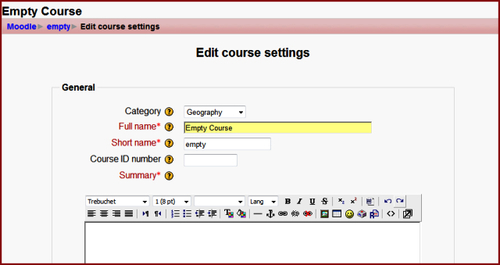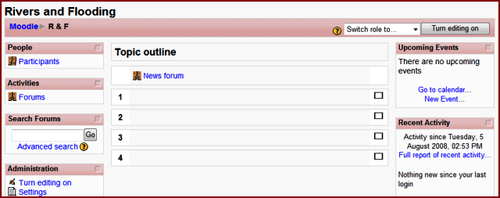1. In the Administration block, click on Settings.

2. Next to Full name, type in the full name of your course (such as Rivers and Flooding).
3. Next to Short name, give your course an abbreviation, which will be seen in the navigation bar. For our example course, we’ll use R & F.
4. In Summary, write a sentence or two to explain what the course is about.
5. Scroll down to the sections shown in the following screenshot:

6. For Format, you can use the default value of Date format to include one section per date in your course page, or you can select Weekly format to include one section per week, or select Topic format to use numbered sections that you can set up as you like. For this example, we will select Topic format.
7. In the Number of weeks/topics field, choose the number of days, weeks, or topics that you want to include on your course page (you can change this at any time). For this example, we will specify 4.
8. If you want your course to start on a particular date (and not immediately), specify this date in the Course start date field.
9. For now, as a beginner, this much will be enough.
10. Click on Save and return to course. Your course page should now look something like this:

We just began customizing our course page to how we want it to look. We've now got the title we want, and the middle section (where our work will go) is now divided into separate numbered sections—four, for us—which will help us to organize our project. At the moment, there's nothing next to these numbers. We need to get into each section, give it a heading, and prepare it so that we can add our worksheets and lessons, which we will do in future chapters of this book. There's something called a News forum too, which I'll describe later. We've also still got those blocks on either side. Obviously, the Administration block is essential, but what about the others? What are they for? Do we need them? And how do we change them? In fact, how do we change anything on the page?



